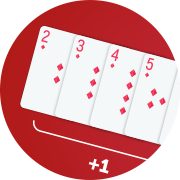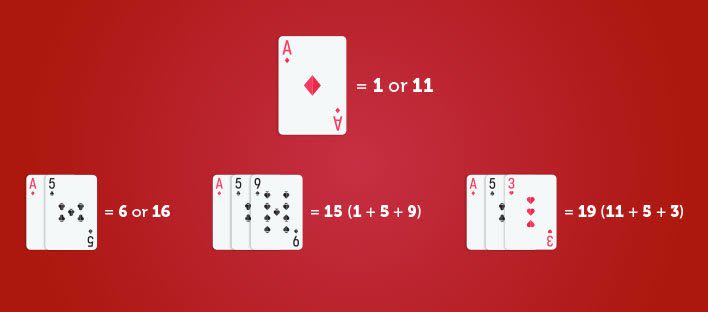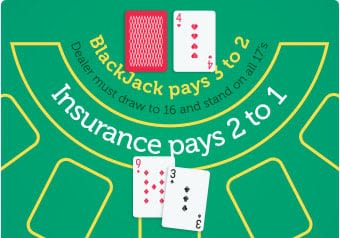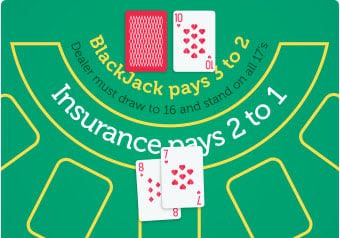Blackjack Strategy - Basic & Advanced
Blackjack is a simple game to understand, but has many different strategies when it comes to winning. Here you’ll learn all about them, from Martingale to d'Alembert, as well as boosting your understanding of the basic rules and card counting. We'll also take you through the popular betting systems for the game.
What is Blackjack Strategy?

Although there is no foolproof way to ensure yourself a win, using a well-practiced strategy can massively increase your chances of winning in a game. This can be done first by knowing the value of the cards, then by mastering card counting in order to know when is better to stand or hit.
The use of strategies has seen many players go from the odd win to becoming highly successful.
Start with Great Basic Knowledge
Blackjack is a game which is known for its simplicity, but it’s not without a few quirks and lesser-known rules. The following list gives an overview of the basic rules of the game. Get to grips with these and you’ll know how to play blackjack.

1. The aim of the game is to beat the dealer by getting as close to 21 as you can, without going over it. If your card total is higher than 21 you’re out and you’ll lose your bet.

2. Players will get two cards to begin with. You'll only see one of the dealer’s cards, but players' cards are both face up.

3. Different variants of the game will have slightly different rules, affecting for example when a player is allowed to surrender or when the dealer must hit/stand, so be sure to check this out.

4. If you get a score of 21 you will likely get 1.5x your total bet, however this depends on the rules of the individual casino.
If you're after some more advanced rules of the game, why not check out our how to play page? After all, developing a good strategy always starts with a comprehensive understanding of how the game works. Less time? Then check out our quick blackjack tips guide.
Understanding Card Values
Most of the card values in blackjack are self-explanatory, with only the number, rather than the suit or color, being of any importance. However, there are a few cards which can trip up newbies when it comes to their value. In blackjack, 10, J, Q and K all have exactly the same value of 10 points. The pictures on the face cards don’t have any impact on their worth.

Aces are the cards which have a special status in blackjack, as they can be worth either one or 11 depending on which is liable to benefit you in a given situation. A starting hand of A5 will have a value of six or 16. If the next card drawn is a nine then the Ace becomes a one for a total value of 15. If you draw a three instead, then the Ace will be used as an 11 to make a strong hand of 19. A starting hand featuring an Ace is usually known as ‘soft’ to indicate that it features the Ace.

Get Stuck into Basic Blackjack Strategy
In Blackjack, you have to make a decision with every hand you're dealt. Do you hit, Stand, Double down, or split? Knowing the right move to make can be tricky at first, which is why we’ve created our handy FREE PDF strategy charts, which you can download and use as you play.
With practice, knowing your odds will become second nature to you. Why not take a look at the following possible scenarios to see what the best moves would be in a given situation:
Scenario 1
The Dealer’s up card is 4. Your Hand is 9 + 3. Hit.
HIT
But why? If you find yourself facing a dealer who shows one card of value 4, while your hand is worth 12, made up of a 9 and 3, a strategy would be to hit. In this situation, you don’t have a much higher chance of going bust than the dealer does. However, the dealer also has a good chance of getting between 17 and 21, a slightly higher chance than yours. On the other hand, you may want to run the risk for the dealer to go bust and therefore stand. The decision to hit is based on the very similar likelihood of achieving a stronger hand: with player probability at around 39% against 42% for the dealer. There isn't a lot of difference. Standing means playing it safe, so you might want to try hitting, due to the minimal disadvantage.

Scenario 2
The Dealer’s up card is 10. Your Hand is 8 + 7. Hit.
HIT
But why?
If your hand is worth 15 and consists of an 8 and 7, and your dealer is showing one card of value 10, we recommend you hit. In this situation the dealer has a high chance of getting a total between 17 and 21, so your best option is to take the risk and attempt to beat this by hitting. The probability for the dealer to get a total between 17 and 21 with the next card dealt is 61.22%, of which it's 40.81% to get 20 or 21. The player's chance to get between 17 and 21 is only 40.81%, so take the risk and hit.

What's the Deal with Card Counting?
Card counting is a technique which is most often used in blackjack. The idea is to use mathematics to work out whether or not a hand is likely to be advantageous to the player or to the dealer, and whether to bet lower or higher. This is calculated by tracking how many small and large cards have been used and how many remain in the deck. Successful application of card counting in a strategy can decrease the house edge by as much as 1%.
Hi-lo Card Counting Strategy
This blackjack card counting technique works by assigning a value of either -1, 0 or 1 to each card dealt face up. You'll often hear the word 'tag' being used in card counting circles. This is just players' slang for any value assigned to cards in this technique.
It's a common alternative to detailed counting of each card – that would require an incredible command of memory and arithmetic skills! Rather than being a foolproof way of knowing the deck, Hi-Lo is based more on approximations.

- Small cards (2, 3, 4, 5 and 6) receive a tag of plus one. This means that their removal from the deck puts the player at an advantage.
- Other cards (7, 8, 9) have a tag of 0, as their removal from the deck does not have a significant impact and therefore they do not need to be counted.
- Large cards (10s, Aces) receive a tag of minus one. Their removal from the deck gives the advantage back to the house.
Using these tags, card counters work out the “running count” of the deck, adding or subtracting whenever a small or large card is removed. They therefore know whether or not the deck leans in their favor, or towards the house, at any given time, and can manage their bets accordingly.
How Card Counting Works in Multiple Deck Games
It’s not impossible to use a card counting strategy in multiple-deck games, but it does make it a little more complicated. Begin by calculating your running count just as you would do in a single-deck game. You then need to ‘normalize’ the running count to take into account multiple decks of cards by dividing the running count by the total number of unplayed decks of cards. This sum gives you something called your “true count”, which can be used in the same way as a running count, by giving you an insight into whether you are at an advantage or not.
Blackjack Betting Systems
Blackjack has inspired many different repetitive/sequential betting systems. These systems apply for a series or sequences of plays, defined through repetitive (or sequential) play. Applying one of these systems is distinctly different from a playing a game strategy. Some players use systems to improve their chances of beating the dealer. Below, are a few of the most common ones.
- 1
Martingale
Players double their bets when they are losing. This strategy can get you back on even ground, wiping out your losses with one big winning bet. But it is risky!
- 2
d'Alembert
When using d'Alembert, players raise their bets by one unit every time they lose. When they win, they lower their bets by one unit. It's known as one of the safer betting systems.
- 3
Fibonacci
This system is based on a famous mathematical sequence called the Fibonacci sequence. In this, each number is the sum of the two previous numbers. The sequence goes like so: 1, 1, 2, 3, 5, 8, 13, 21, 34, and so on. As a betting system, players’ bets progress along the Fibonacci sequence each time they lose. If they win, they stick with the number they were on when they won. The strategy is similar to Martingale but is somewhat less aggressive.
- 4
1-3-2-6
Known as a split strategy, 1-3-2-6 sees players bet 1, 3, 2 and 6 units consecutively. Unit bets only go up if the player wins. If the player loses, they remain on 1 unit until they win again.
- 5
Parlay
This is what’s known as a positive progression betting system. In Parlay, the idea is to create a pyramid of winnings. If the player wins, he/she will bet the winnings and the original bet. If the player loses, he will bet his/her original amount.
- 6
Oscar's Grind
Originally designed for the game of craps, Oscar’s Grind has been successfully applied to Blackjack. The system is a progressive one, which sees bets increase by one unit if the player wins. Every time the player wins, the bet is doubled again.
Blackjack Glossary
Now you know how to play like a pro, learn how to talk like one too! Below are the top terms used by players and dealers when playing Blackjack. If you’re interested in learning more popular gambling and casino terms check out our extensive gambling and casino glossary.
| Term | Definition |
|---|---|
Bankroll | The sum of all money that you have access to for gambling purposes. Keep this separate from the college fund! |
Burn Card | This is the first card drawn from the top of the deck. Named because it is “burned” (removed from the deck) to disrupt the order of the cards and foil attempts at cheating. |
Bust | A hand that is worth more than 21. This automatically results in a loss of your bet and can only be achieved after “hitting”. A bust is always avoidable since your starting two cards can never be worth more than 21. |
Card Counting | A potentially effective system of tracking the cards that remain in a blackjack deck to determine the likelihood of the dealer “busting”. Card counting is never effective online, as a random number generator is used. |
Deck Penetration | The percentage of cards that have been in play since the previous shuffle. Important information for card counters. |
Double Down | The choice to double your original bet (typically with a strong hand) with the limitation that you must accept exactly one more card. This cannot be performed on a hand that contains more than two cards. |
Face Cards | These are the Kings, Queens, and Jacks in a deck. |
Flat Betting | Betting the same for each hand. No variation in bet size. Typically considered a bad strategy, though it makes sense if you aren't counting cards. |
Griffin Book | A listing of known card counters (referred to as a black book) which circulates among casino security workers in brick and mortar casinos. It is named after Griffin Investigations: the company that is responsible for publishing and circulating this document. |
Hard Hand | A hand that can only have one value – either without any aces, or a hand with a high enough value that any aces can only be worth 1. |
Heads Up | When there is only one player playing at the blackjack table. Most online games are played heads-up. |
Hit | Requesting an additional card from the dealer in hopes of improving one's blackjack hand. |
House Edge | Generally, house edge refers to the casino’s long-term advantage, expressed as a percentage of player’s initial bet. House edge for a certain bet is the difference between the payout percentage offered by the casino when you win that bet, and the real probability of that event occurring. House edge is specific to games, bets, players and strategies. |
Natural | A hand that does not require any action to be worth 21. Only contains two cards. This hand cannot lose. |
Paint | A slang term used by blackjack players to refer to face cards. |
Push | Tying with the dealer with a non-busted hand; this results in neither a win nor a loss. |
Soft Hand | Any hand that contains one or more aces that can be worth either 1 or 11. Since this hand has a degree of flexibility, it protects you from busting after a hit. |
Surrender | The decision to forfeit a blackjack hand and have half of your wager returned to you. This cannot be performed after any other action (e.g. hitting, doubling down, etc). It's just based on receiving an unfortunate hand at the start. |
Up Card | The dealer's card which faces up. It provides valuable information for any player attempting to follow basic strategy or count cards because it clues you into the house's prospects. |
Time to Play Blackjack?
So, you’ve heard all about blackjack strategy and download our strategy charts. You’ve read up on card counting and you’ve found out all about the best-known blackjack betting systems which you might want to try out. Now, it must be time to try your luck at the game! Check out our top rated real money online casinos to get started.
FAQ
How do I play blackjack online?
Blackjack is available to play online at all top blackjack casinos. Take a look at our recommended sites for a full selection of available casinos and get started on your desktop computer or mobile device. You can even play and practise blackjack for free on either device.
Is online blackjack rigged?
All casinos listed here on Casino.org offer games which are totally fair and random. However, not all casinos do this. That’s why we recommend you stick to reputable names and trustworthy sites. Casinos which do not score highly are added to our list of sites to avoid, so make sure not to visit these.
How do I bet in online blackjack?
In online blackjack, you’ll be able to place your bets before the hands are dealt, just as you would in the traditional table game. You can also change your bet by doubling down or surrendering within the game.
When should I hit or stand?
If you’re in doubt as to what move you should make, take a look at our free blackjack strategy charts. These charts will give you the best advice on what you should do in any given situation.
How do people count cards?
Card counting is a mathematical way of assessing player’s or house’s advantage in terms of the likelihood of some outcomes, by basing only on the seen cards. This is done by assigning values to small and large cards, and keeping a running total of what is left in the deck at any one time. Successful card counters increase their edge over the house and play at an advantage.

